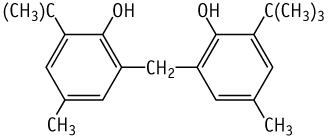

2,2'-Methylenebis(6-tert-butyl-p-cresol) was studied for oral toxicity in rats in an OECD preliminary reproduction toxicity screening test at doses of 12.5, 50, 200, and 800 mg/kg/day (12 animals of each sex).
In the males, food consumption was decreased transiently in the 800 mg/kg group. At necropsy, atrophy of the testes and epididymides was noted in the 200 and 800 mg/kg groups, and atrophy of the seminal vesicles in the 800 mg/kg group. Regarding organ weights, decreases in the absolute and relative testis and epididymis weights were noted in the 200 and 800 mg/kg groups. Regarding sperm examination, decreases in the motility ratio, viability ratio, survivability ratio, and the number of sperm in the epididymis cauda and an increase in the abnormal sperm ratio were apparent in the 50 and 200 mg/kg groups. In the 800 mg/kg group, no motile sperm were evident, the number of abnormal sperm tended to increase, and the total number of sperm was decreased. Regarding histopathological examination, the following were noted: giant cell formation in the testes in the 50 mg/kg group; atrophy and degeneration of seminiferous tubules, and giant cell formation in the testes in the 200 mg/kg group; and atrophy of seminiferous tubules in the 800 mg/kg group.
In the females, suppression of body weight gain was noted in the 200 mg/kg group during the lactation period and in the 800 mg/kg group during the pregnancy and lactation periods. Lower food consumption was noted in the 200 and 800 mg/kg groups during the pre-mating, pregnancy, and lactation periods.
The NOELs for repeat dose toxicity are considered to be 12.5 mg/kg/day for males, and 50 mg/kg/day for females.
With regard to reproductive/developmental toxicity, 1 dam was unable to deliver pups, and 1 dam lost all their pups during the lactation period in the 800 mg/kg group. Decreases in the number of corpora lutea, number of implantation scars, and number of pups born were noted in the 200 and 800 mg/kg groups.
The NOELs for reproductive performance are considered to be 12.5 mg/kg/day for males, and 50 mg/kg/day for females.
With regard to pups, the number of pups on days 0 and 4 of lactation decreased in the 200 mg/kg group. In the 800 mg/kg group, the number of pups on days 0 and 4 of lactation, live birth index, and body weights of both sexes on day 4 of lactation were decreased, and the number of stillbirths increased. The NOEL for pup development is considered to be 50 mg/kg/day.
| Purity | : | 98.2 % |
| Test species/strain | : | Rat/Crj:CD(SD)IGS |
| Test method | : | OECD Preliminary Reproduction Toxicity Screening Test |
| Route | : | Oral (gavage) |
| Doses | : | 0 (vehicle), 12.5, 50, 200, 800 mg/kg/day |
| Number of animals/group | : | Males, 12; females, 12 |
| Vehicle | : | 5 % gum arabic |
| Administration period | : | Males, 50 - 52 days Females, from 14 days before mating to day 3 of lactation |
| Terminal kill | : | Males, day 51 - 53 Females, day 4 of lactation |
| GLP | : | Yes |
Test results:
In the males, giant cell formation in the testes, decreases in sperm motility ratio and number of sperms in the epididymis cauda, and an increase in abnormal sperm ratio were noted in the 50 mg/kg group. Atrophy of the testes and epididymides, decreases in the absolute and relative testis and epididymis weights, atrophy of seminiferous tubules, degeneration of seminiferous tubules, a decrease in sperm in the epididymis cauda and giant cell formation were noted in the testes, and a decrease in the sperm motility ratio and an increase in the abnormal sperm ratio were apparent in the 200 mg/kg group. In the 800 mg/kg group, a transient decrease in food consumption, atrophy of the testes, epididymides and seminal vesicles, decreases in the absolute and relative testis and epididymis weights, and atrophy of seminiferous tubules in the testes were noted. On sperm examination, no motile sperm were noted, the number of abnormal sperm tended to increase, and the number of sperm in the epididymis cauda were decreased at 800 mg/kg.
In the 200 mg/kg females, suppression of body weight gain was noted during the lactation period, and lower food consumption was evident during the pre-mating, pregnancy, and lactation periods. With 800 mg/kg, suppression of body weight gain was noted during the pregnancy and lactation periods, and lower food consumption was noted during the pre-mating, pregnancy, and lactation periods.
The NOELs for repeat dose toxicity are considered to be 12.5 mg/kg/day for males, and 50 mg/kg/day for females.
<Reproductive/Developmental Toxicity>
With regard to reproductive/developmental toxicity, 1 dam was unable to deliver pups, and 1 dam lost all their pups during the lactation period in the 800 mg/kg group. Decreases in the numbers of corpora lutea, numbers of implantation scars, and numbers of pups born were noted in the 200 and 800 mg/kg groups.
The NOELs for reproductive performance are considered to be 12.5 mg/kg/day for males, and 50 mg/kg/day for females.
With regard to pups, numbers on days 0 and 4 of lactation were decreased in the 200 mg/kg group. In the 800 mg/kg group, the number of pups on days 0 and 4 of lactation, live birth index, and body weights of both sexes on day 4 of lactation were decreased, and the number of stillbirths was increased.
The NOEL for pup development is considered to be 50 mg/kg/day.
| 1) | The test was performed by Nihon Bioresearch Inc., Hashima Laboratory, 6-104 Majima, Fukuju-cho, Hashima, Gifu, 501-6251, Japan. Tel +58-392-6222 Fax +58-392-1284 |